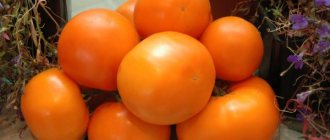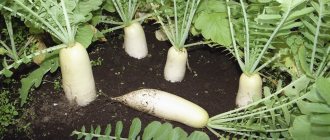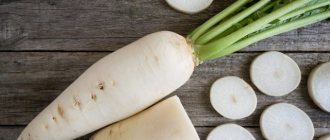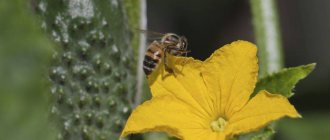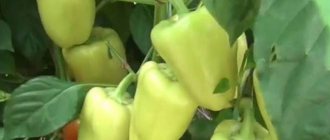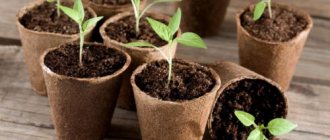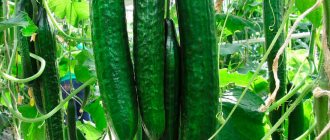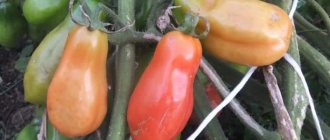Daikon Minowasi is a variety that is preferred only by experienced gardeners. The reason is that the plant is only able to develop when daylight hours are waning. When planting early, the root crop certainly goes in the direction.
Late-ripening vegetables must be planted in the ground in the second half of summer, which disrupts the usual rhythm of agricultural work.
History of variety selection
Daikon is a type of radish and radish. However, unlike them, it does not have a specific bitterness. Japan is considered the birthplace of the root vegetable. There, daikon is in first place in terms of crop area.
In Russia, the culture did not receive such a spread. However, some gardeners grow vegetables. Daikon Minowashi is one of the few popular varieties. In 2005, the Avista company applied to register Minovasi. And since 2007, the variety has been included in the State Register of the Russian Federation.
Advantages and disadvantages
Even in ancient times, the Japanese appreciated the taste and unique properties of daikon. Not a single family can live without this product; root vegetables are used in many cuisines of other countries, in folk recipes for the treatment of diseases.
See also
When to harvest daikon radish from the garden for storage for the winterRead
The Minovasi variety is not afraid of heat, but suffers from low temperatures, and has many advantages, including:
- delicate taste of the pulp;
- lack of bitterness;
- high yield.
Not only root vegetables are eaten, but also young tops and leaves. One vegetable weighs up to 1.5 kg, and more than 10 kilograms are harvested per square meter. Minowasi are planted by digging up potatoes, garlic, picking tomatoes or onions. The plant does not accumulate toxins, but has medicinal properties. Root crops have time to ripen even when sown in the second half of summer.
A significant disadvantage of the variety is that with long daylight hours, the yield decreases sharply, as arrows form, which is why the development of root crops stops.
Minowasi reacts negatively to low air temperatures.
Description of the Minowashi daikon
The length of the root crop of the Minovasi variety reaches 60 cm, and its diameter is 10 cm. The root weight reaches 1.5 kg. The shape of the fruit is cylindrical, tapering towards the tip. The foliage in the rosette is located vertically upward, the outermost one leans towards the ground. The leaves are dissected, dark green with a gray tint, medium size.
The pulp of the Minowasi root vegetable is juicy, tender, and dense. There is no such thing as porous and loose. The taste is sweetish. The skin is thin, white, green near the base.
Attention! Daikon leaves of the Minowashi variety are used to make salads.
Description of the variety
A distant relative of mid-season vegetable species is loba. By crossing this green radish, the Japanese obtained a root vegetable that is as common among them as potatoes in Europe and America. In Russia, some summer residents have been growing Minovasi for almost 10 years. It is this variety that is present in the register of breeding achievements.
The daikon root vegetable is much larger than the radish. In 2 months it grows to almost half a meter in length. The diameter of the upper part of the vegetable does not exceed 10 cm; it tapers at the bottom. "Big root" has:
- cylindrical shape;
- delicate and thin skin;
- juicy and dense pulp;
- sweetish taste.
The dissected leaves form a beautiful rosette. They, like root vegetables, do not accumulate pesticides or toxic substances and are consumed fresh. When the vegetable ripens, it rises above the garden bed, covered with lush greenery on top.
The refreshing pulp of Minowasi contains:
- pectins;
- phytoncides;
- proteins;
- beta-carotene;
- microelements.
The root vegetable helps cleanse the body of waste and toxins. When consumed, swelling goes away, the liver restores its functions, radioactive particles are eliminated, and cholesterol levels decrease. The vegetable speeds up the treatment of influenza and copes with acute respiratory infections.
Characteristics of the variety
The Minowasi daikon variety is recommended for cultivation in all regions of the country. Late ripening variety. Biological maturity of the fruit occurs approximately 70-75 days after sowing the seeds. But you don’t have to wait for this period, but consume daikon 7-10 days earlier. In order for a vegetable to have a long shelf life, it must be fully ripe, its taste retained for up to six months.
Attention! Seeds of early ripening daikon Minowashi are available for sale, the fruit ripening time is 50 days, the length of the root crop is up to 40 cm.
There are also other “doubles” of the variety.
Productivity
According to the varietal characteristics of the Minowasi daikon, from 1 sq. m harvest up to 13 kg of crop. After harvesting, the fruits are shaken off the ground, dried a little and transferred to a dark place. Favorable storage temperature is 0-5 °C. Shelf life 2-3 months.
Resistance to diseases and pests
If agricultural practices are incorrect, the Minowasi daikon suffers from the following bacterial diseases:
- vascular and mucous bacteriosis;
- mosaic;
- clubroot;
- blackleg.
To cope with the infection and remove it from the garden, you need to use antibacterial drugs, such as Planriz and Binoram.
Among the pests that pose a real danger to root crops are slugs, cabbage flies, cruciferous flea beetles, cutworms, and aphids. You can fight parasites using laundry soap, a low concentrated solution of potassium permanganate, hot red pepper and other folk methods. Or resort to bioinsecticides in the form of “Bitoxibacillin”, “Actofit”, “Lepidotsid”. They should be used according to the attached instructions.
Advantages and disadvantages of the variety
The daikon variety Minowashi is characterized by the following positive qualities:
- precocity;
- productivity;
- the possibility of planting daikon after the previous batch of vegetables has already been collected;
- excellent taste;
- valuable mineral composition of the root crop;
- absence of increased requirements during the growing process;
- environmental friendliness, the vegetable does not accumulate harmful substances.
Now about the disadvantages. Firstly, it is low frost resistance. Air temperatures of + 10 °C and below will be considered unfavorable for daikon of the Minowashi variety. Secondly, long daylight hours. As a result, the root crop blooms and loses valuable taste. The vegetable is planted in early spring or late summer.
Diseases and pests
Daikon Minowashi may be affected by the following diseases:
- mucous bacteriosis;
- mosaic;
- felt disease;
- blackleg.
If plantings are affected by fungal diseases, you can use Binoram and Planriz.
A good preventive effect is achieved by pre-planting disinfection of seeds with a solution of potassium permanganate. It can also be used to treat a garden bed if pests appear on it. Planting marigolds in the neighborhood will help protect plantings from insect invasion.
Planting and caring for Minowasi daikon
Growing daikon is as easy as growing any other vegetable. The only difficulty is choosing the right time for planting. Everything depends not even on the climatic characteristics of the region, but on the weather conditions on the day of landing. It is important that the vegetable goes to the root and does not begin to bloom.
Landing dates
There are spring and summer plantings of daikon.
In spring, it is better to plant vegetables as early as possible. You should not be afraid of cold weather; the seeds will survive even severe frosts. However, the fruit of spring daikon cannot be stored for long. It, like radishes, should be consumed after ripening. This vegetable is also more prone to bolting. When growing in greenhouses, it is better to plant at the end of March or early April. For open ground, the time shifts slightly - the last week of April or the beginning of May.
In summer, daikon varieties Minowasi are planted from early July to early August. Usually, root crop seeds are sown in beds after dill, green onions, and lettuce. The advantage of summer planting is that there are fewer pests during this period, and such a vegetable is capable of long-term storage. However, the root crop may not have time to grow to its maximum size.
Attention! Minowashi daikon seeds are selected for a specific planting period.
Preparing the bed
It is advisable to choose a sunny site for daikon. When growing a plant in the shade, the foliage will be thin and long, and the root crop itself will be small and gnarled. The beds where tomatoes, potatoes, cucumbers, and onions were previously grown are well suited. Radishes and cabbage are not the best predecessors. The Minowasi daikon variety is undemanding in terms of soil composition. The only thing is that it is harder to pull a ripe vegetable out of dense soil.
Preparing a site for planting daikon involves digging up the soil, which has been previously fertilized. For 1 sq. m need:
- humus with a volume of 10 liters and 200 g of wood ash;
- 10-15 g of potassium sulfate and urea;
- 20-30 g of nitroammophoska.
Attention! Experienced gardeners advise not to ignore this stage, since the land is depleted and has already yielded its harvest.
This mineral complex is used to replenish the soil, restoring reserves that have been used up.
Landing rules
Having decided on the timing of planting the Minowashi daikon, you should move on to the immediate process of planting and care afterwards.
- Furrows are formed on the bed at a distance of 50-60 cm from each other, 3 cm deep.
- Water the soil with warm water and wait until it is completely absorbed.
- Seeds of the Minowashi daikon variety are planted every 20 cm.
- Sprinkle with earth and tamp down a little.
- For faster germination, the area is covered with film or agrofibre.
- After 5-6 days, the shelter is removed.
Advice! There is no need to water the seeds from above; they are already in a humid environment.
Aftercare
Further measures for caring for vegetable crops include regular watering, loosening, and weeding.
Minowashi daikon should be watered regularly and moderately. Lack of moisture makes it bitter, dry and harsh in taste. Excessive moisture leads to cracking of the fruit. On average, it is enough to water once every 5 days. On hotter days, the procedure should be done more often. During the rainy season - less often. It is necessary that the soil around the daikon is moist. Dry soil will have negative consequences.
During the entire growing season, you need to ensure that no weeds grow near the plant and that the soil is loose. After each moistening procedure, the soil must be weeded and loosened. When the roots appear on the surface, they begin to hill up to protect them from possible damage.
Advice! A mulching layer of straw or peat will help make maintenance easier.
Rules for caring for radishes in open ground
Watering
Daikon Minowashi needs to be watered 2-3 times a week, and in hot and dry weather – daily. It is important to ensure that the soil at the roots is moist. Watering should be done early in the morning or in the evening.
Temperature
Since Minowashi daikon is grown in open ground, it is impossible to regulate the temperature. The optimal temperature for its growth is 18-25 °C. It is important to water abundantly in hot weather, preventing the soil from drying out.
Weeding
Proper care of Minowasi includes regular weeding to remove weeds and loosen the soil. When the root crop begins to rise above the surface of the earth, it needs to be hilled.
Top dressing
To obtain a high yield of daikon, it must be fed with complex fertilizers. Perfect for these purposes:
- "Agricola".
- “BioHumus”.
- “Fertika” and others.
The optimal number of feedings is 2, with an interval of 2 weeks. Do not feed Minowasi with bird droppings and mullein. When feeding with organic matter, the tops will grow intensively, not the root crops.
Collection and storage
2 weeks before harvesting, stop watering the Minowashi daikon variety. And moisten the soil slightly before harvesting. The root crop itself is dug up and carefully dragged by the tops. The main thing is that it doesn’t break off. Deformed, broken, diseased plants cannot be stored for long periods of time. They are used first.
After drying, remove the soil and leaves. You can store the vegetable in the refrigerator or cellar. The shelf life for the Minovasi variety is up to six months.
Attention! To prevent root vegetables from wilting, you need to monitor the humidity level.
Storage
After digging up Minowasi, it needs to be dried. Then you need to trim the tops, leaving small 2-3 cm “stumps”.
For winter storage, only mature, undamaged root crops are selected and placed in boxes, sprinkled with river sand. Store daikon in the basement.
Read how to clean and store any daikon here.
Gardeners will also be interested in information about other varieties of daikon, including those that are suitable for growing in open ground in the Moscow region.
By observing the sowing time and providing proper care, even a novice gardener can get a rich harvest of Minowashi daikon. Its juicy root vegetables with a pleasant, sweet taste will please everyone. Minowasi will be a source of vitamins in winter and will perfectly complement any dish.
Pest protection and disease prevention
For prevention purposes, you need to:
- observe crop rotation and agricultural technology;
- grow disease-resistant varieties;
- carry out pre-sowing treatment of planting material;
- destroy pests in a timely manner;
- Remove weeds regularly.
For protection after sowing, dust with wood ash and sprinkle the soil with lime or a layer of powdered superphosphate. A good result is obtained by spraying with onion-garlic infusion or bioinsecticides in the form of “Actofit”, “Bitoxibacillin” and “Lepidocide” according to the instructions supplied with the drug.
The best varieties of daikon
Of course, Chinese radish is not as popular in our country as radishes, but growing this crop is not at all difficult, and if the cultivation technology is followed, it allows you to harvest a high and high-quality harvest.
Daikon Minowasi
An early ripening variety, resistant to disease and heat , not prone to bolting. The length of the cylindrical root crop is half a meter with a diameter of 70-120 mm. The average weight of the fetus is one and a half kilograms.
Daikon: beneficial properties (video)
Sasha
A domestic variety of early ripening , with relatively small rounded root crops weighing up to 500 g and very tender pulp. It is resistant to low temperatures and early flowering, which allows you to grow a high yield.
Dubinushka
Root vegetables of the “Dubinushka” variety can be stored for a long time. Medium ripening , with cylindrical root crops up to half a meter long and weighing up to 2 kg. The pulp is pleasant, white.
Emperor
A highly productive, heat-resistant and disease-resistant variety with bright red root crops and white juicy pulp. Up to 50-60 cm long. Perfect for spring and summer sowing.
Favorite
Medium ripening variety. It has excellent culinary, taste and commercial qualities. It is resistant to early formation of shoots. The root crop is cone-shaped, white in color with a greenish tint to the head. Weight does not exceed half a kilogram.
Tokinashi
Belongs to the category of high-yielding varieties of early ripening. It forms cone-shaped root vegetables with good taste, no more than 50-60 cm in length. Not only the pulp of the fruit, but also the petioles and leaves have nutritional value.
Japanese long white
Characterized by very high yields and guaranteed resistance to flowering. Root vegetables do not have flabbyness. It is necessary to dig up the harvest at a later date , and with proper organization of storage, the harvested crop can be preserved without loss of taste and quality for a long time. The flesh is slightly spicy. The length of the root crop is on average 55-65 cm, with a weight of up to 3.0 kg.
Elephant Tusk
The mid-season “Elephant Tusk”, popular in our country, is highly productive. The shape of the root crop is long and cylindrical. The juicy and tender pulp completely lacks a specific bitterish-sharp aftertaste.
Features of daikon radish
Daikon can be an annual or biennial. Over time, the plant should form a rosette, which consists of 12–40 heavily dissected leaf blades. It also produces a root crop that is larger than radish; it weighs 0.6–4 kilograms, but sometimes root crops weighing about 20 kilograms are found. Such fruits do not have the pungency inherent in radishes, and their flesh is also more tender and juicy. This radish has good shelf life and is grown quite successfully in mid-latitudes. The duration of the growing season is 40–200 days, and it directly depends on the variety. This plant is considered a relative of radishes, cabbage, turnips and other less well-known representatives of the Cruciferous family. Every year this crop is becoming increasingly popular among gardeners, because daikon is highly productive and unpretentious.
How I grow daikon
Properties of daikon: harm and benefits
Useful properties of daikon
Daikon is a low-calorie product that contains a very large amount of vitamin C. Root vegetables also contain an enzyme that helps improve the digestion of starches. In this regard, fruits are recommended to be included in the diet of people who want to lose excess weight. They also contain phytoncides, which improve the body's resistance to various infections. And the layers of potassium they contain help the body to rid itself of waste, toxins, and excess fluid. They also contain substances such as esterase, amylase and enzymes, which help normalize metabolic processes in the body, and also improve the absorption of fats, carbohydrates and proteins. In addition, the fruits of this plant contain magnesium, phosphorus and iron salts, fiber and pectins, a large amount of beta-carotene and B vitamins.
Daikon is recommended for use in the treatment of cardiovascular diseases and atherosclerosis. If you eat it raw, a person’s appetite will improve, and his body will be cleansed of excess cholesterol, and it also helps eliminate radiation. Immediately before meals, it is recommended to drink 1 tbsp. juice of such a plant, since it contains sulfur, which has a positive effect on the functioning of the gallbladder and liver. For respiratory diseases (asthma, colds, bronchitis, chronic cough and flu), experts also advise drinking daikon juice, as it has an antimicrobial and antiviral effect. 0.2–0.3 kg of grated root vegetables will help get rid of a hangover. To remove freckles, heal purulent wounds, and also make hair stronger, this juice is recommended to be used externally in the form of lotions and compresses.
DAIKON BENEFITS AND HARM / Loba benefits and harm, how daikon is useful, loba beneficial properties
Nuances of caring for vegetables
- To protect crops from cruciferous flea beetle, seedlings are pollinated 3–4 times with ash or tobacco dust at intervals of 4–5 days or covered with non-woven materials.
- The soil for daikon must be deeply processed - otherwise any obstacle to the growth of the root crop will cause the fruit to become distorted.
- Organic fertilizers applied immediately before sowing reduce the marketability - distorted fruits are formed.
- When the day length is more than 15 hours, the formation of root crops is delayed in daikon.
- With early sowing, when long days are combined with low average daily air temperatures, flowering is less than when sowing in June.
- Daikon can be sown in its original place no earlier than after 4–5 years.
Fragile and delicate daikon roots require careful handling . If the soil is thoroughly and deeply processed, a shovel or digging tools will not be required during harvesting. At the end of July, when the area is cleared of garden crops, you can plant daikon seeds in empty beds and get a rich harvest in September.
Varieties and hybrids
During the selection process, more than 700 varieties and hybrids were created, differing in early ripening, shape and size of the fruit, and immersion in the soil. For central Russia, varieties recommended for greenhouses are Sasha, for open ground:
- Bludgeon;
- The Dragon;
- Caesar;
- Favorite;
- Minowasi;
- Moscow hero.
Table. Characteristics of daikon varieties and hybrids
| Variety | Fruit weight (kg) | Form |
| Early ripening – growing season 30–60 days | ||
| Sasha | 0,1–0,4 | Round, round-oval |
| Rhinoceros | 0,3–0,4 | Conical |
| Vakula | 0,4–0,8 | Cylindrical |
| Barchonok | 0,4 | Round |
| Misato Pink Glitter | 0,5–0,9 | Round or flat-round |
| Mid-early with a growing season of 60 to 70 days: | ||
| Mino Same Cross F₁ | 0,4–0,5 | Conical |
| Caesar | 0,6–1,0 | Cylindrical |
| Autumn handsome | 0,3–0,42 | Elongated elliptical |
| Diamond | 0,23 | Round |
| Dubinushka | 0,6–2,0 | Cylindrical |
| Favorite | 0,5–0,6 | Conical |
| Mid-season – 70–85 days | ||
| Emperor F₁ | 0,5–0,6 | Icicle-shaped |
| Elephant Tusk | 0,3–0,6 | Elongated cylindrical |
| The Dragon | 0,9–1 | Cylindrical |
| Moscow hero | 1,0–1,5 | Cylindrical |
| Mid-late 86–90 | ||
| Minowasi PC | 1,0–1,5 | Cylindrical |
Early ripening varieties, such as Sasha, Barchonok, Rhino, are sown in two periods - in April in a greenhouse, in open ground in the 2nd decade of July. The most resistant to flowering are the Minovasi and Sasha varieties.
Daikon seeds can be purchased in specialized stores or ordered from online stores. The cost of 1 g of seeds in Moscow and St. Petersburg - depending on the variety and quantity - is from 16 rubles per 1 g. 1 g of seeds contains from 90 to 140 pieces.
Features of cultivation
The best daikon crops are formed on light, fertile soils with deep groundwater. A good harvest requires deep autumn and spring tillage. On heavy loamy soils, high-quality root crops can be obtained if varieties with slightly submerged roots - no more than half the length - are planted on the ridges.
During the growing season, 5–6 waterings are carried out . The irrigation rate per 10 m² is 350 liters of water. Before planting, the seeds are soaked in a solution of potassium permanganate - 0.2 g per 1 liter of water. When air humidity is less than 60%, the development of root crops is delayed - the formation of woody elements and the accumulation of bitterness are enhanced.
Compatibility with other crops
Daikon can be cultivated after any crop, with the exception of representatives of the Cabbage family, with which it shares diseases and pests. The best predecessors:
- potato;
- tomato;
- cucumber;
- celery;
- salad;
- pumpkin
Daikon can be combined with other crops and grown in dense plantings. No negative effect of daikon on the yield of other crops has been noted. On the slopes of high ridges (35–40 cm) the following are sown:
- dill;
- parsley;
- turnip.
In re-culture, daikon is cultivated after harvesting:
- cereals;
- early vegetables;
- potatoes.
Sowing time
Daikon is planted in open ground in the 2nd decade of May, 2nd decade of June, 2nd and 3rd decade of July. Sowed indoors in the 3rd decade of February.
Reference! In the early stages of planting, the weight of the root crop is higher, and the yield is lower, since early-planted daikon is more susceptible to flowering.
What to cook from Minowasi
The root vegetable itself is grated, mixed with mayonnaise and herbs, marinated in vinegar, served with fish, added to soups, and this vegetable is also stewed with squid and octopus. For the winter, daikon rings are dried and salted. Winter preparation of takuan is a traditional Japanese dish. For this purpose, daikon is first dried and then fermented with spices. Minowashi can also be prepared in Korean. In general, this vegetable is used in many national cuisines. In Russia they prefer to eat it fresh, mainly in salads.
Photo gallery: Minowasi daikon salads
The process of growing Minowasi is simple but unconventional. It is sown at the end of summer; the soil needs to be loose. The main thing in care is regular watering. Harvesting causes difficulties: pulling a 60-centimeter fragile root crop out of the ground is not so easy. But all the efforts pay off; not a single daikon lover has ever said that Minowashi is tasteless.
Daikon Minowashi: how to grow a large and juicy root vegetable from yagodka.club.
How to grow
Planting and care are reminiscent of radishes - it’s not for nothing that they are relatives. Daikon varieties with short round roots are most often grown through seedlings, but Minowasi, with their long roots and long tender roots, do not like transplanting and picking, so it is better to sow them directly into the ground. The soil should be light, loose, fertile and non-acidic. Daikon is not so picky that it will grow in any soil, but the quality of the harvest will correspond to the conditions that were created for it.
You can’t grow it after your cruciferous relatives, if you plant it in a garden bed after cabbage, radishes or turnips, but no amount of resistance built into it by breeders will save you from diseases, so it’s better not to take risks. The most successful predecessors are tomatoes, potatoes, cucumbers, beets and carrots. It is especially good if the bed under them is generously fertilized with organic matter. But even if you haven’t fertilized them, then in the fall after harvesting them you need to carefully dig up the area, remove all weeds, roots, plant debris, add at least 2 kg of compost or humus per square meter, add ammonium sulfate, superphosphate and potassium sulfate. If the soil is acidic, then you need to add lime a couple of weeks earlier, and only then fertilizer.
It is very important to water the plants regularly - lack of watering will make the roots tough and bitter, and uneven watering will contribute to their cracking. On average, we can say that watering is done every five days; during droughts it should be done more often, and after rains - less often. The main thing is that the soil around the roots is always moist; drying out will have a bad effect on the quality of the crop.
Throughout the growing season, you need to make sure that there are no weeds around the plants, and that the soil is loose enough, that is, it is necessary to weed and loosen it, and also hill up the root crops, which will begin to actively crawl out of the ground. Plants are hilled up to protect the future harvest from accidental damage. Mulching with peat or compost will help make the work easier.
If necessary, fertilize the soil; this can be easily done simultaneously with watering. It is best to use complex mineral fertilizers, but you should not add additional organic matter, otherwise the radish will begin to branch. Wood ash, which is usually used to repel pests, makes an excellent fertilizer.
Mucous bacteriosis, clubroot, mosaic, felt disease, black leg - all these diseases of radish can threaten its Japanese relative. The best prevention is compliance with agrotechnical rules. So you need to follow the rules of crop rotation, treat the seeds before sowing with a solution of potassium permanganate, not only weed the beds in a timely manner, but not throw away plant debris, but destroy, check the plants and, if possible, fight pests that often spread diseases, do not over-wet the soil.
If fungal diseases have penetrated the garden bed, the use of biological products “Binoram” and “Planriz” will give a good result. You can’t get rid of the mosaic so easily; you will have to destroy the affected plant, and thoroughly spill the hole and the soil around it with a strong solution of potassium permanganate. Wood ash can repel slugs, so it is worth digging a small ditch around the bed and filling it with ash, and if you cover the ground with it, this can protect you from the cabbage flea beetle. Many harmful insects are repelled by the smell of marigolds; they can be planted around the perimeter of the garden bed. And if the insects have nevertheless penetrated and are trying to lay larvae, then it is worth spraying the plants with an infusion of hot pepper and a weak solution of potassium permanganate.
The crop is harvested as it ripens, usually 60 or 70 days after sowing, choosing a dry, fine day for this. You should not leave ripe root crops in the ground - in the summer the plant will go to waste and spoil the taste of the harvest, and in the fall frosts will come. From light soil, long thick root vegetables are simply pulled out by the green hair, and if the soil is dense, then it is better to use a pitchfork; a shovel is also possible, but there is a greater risk of injury. The extracted crop should be left directly on the garden bed so that the soil adhering to it dries out. If the sun is strong, it is better to move it to the shade. It is not worth stripping the soil - the skin of the root crop is very thin and delicate, if it is injured, it will no longer be stored.
If it is a winter radish, then its greens are cut off or torn off (unscrewed), sorted very carefully, absolutely intact specimens are placed in boxes with wet sand, avoiding contact with each other, and taken to the cellar. At temperatures from + 1 to + 5 it will be perfectly stored almost all winter. Of course, the drawers and the entire cellar must be cleaned in advance from possible fungal infection. Radishes can also be stored in separate plastic bags filled with sawdust or sand, you just need to make holes for air circulation.
